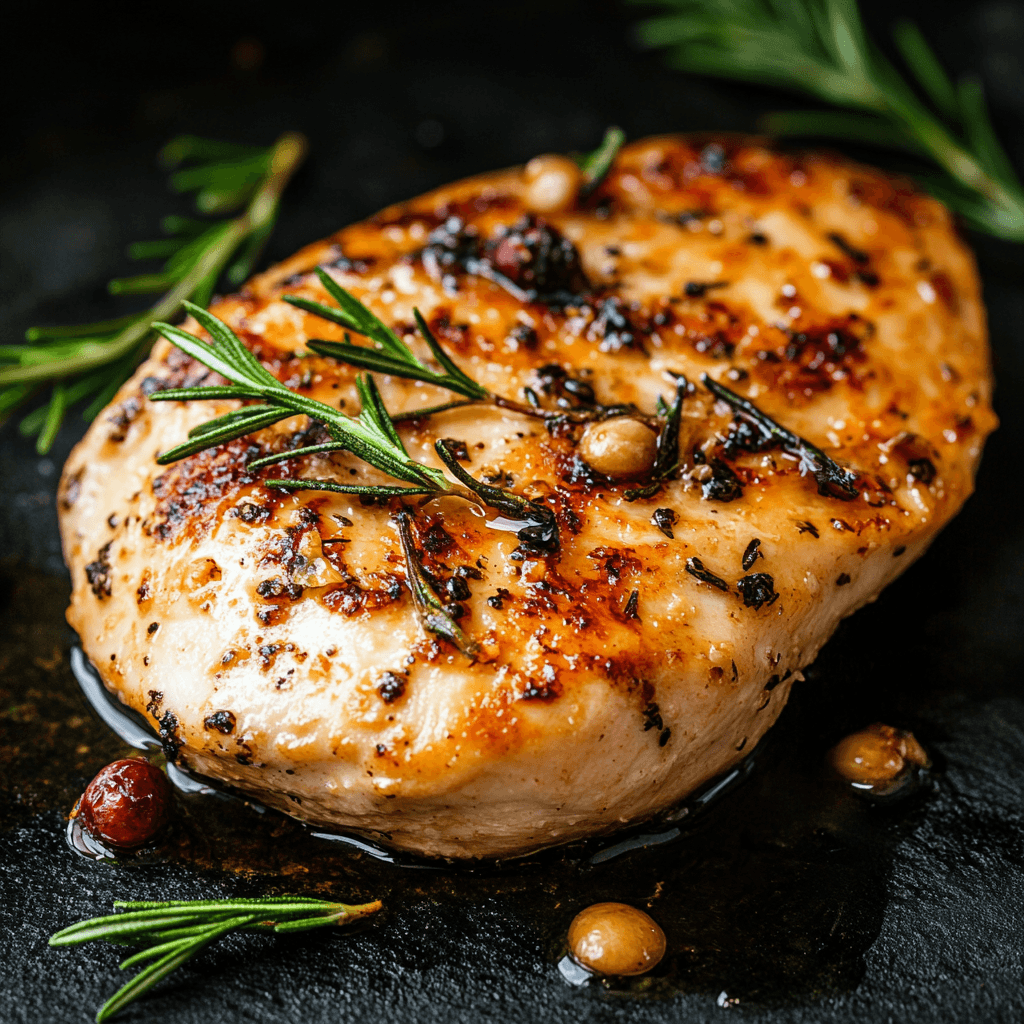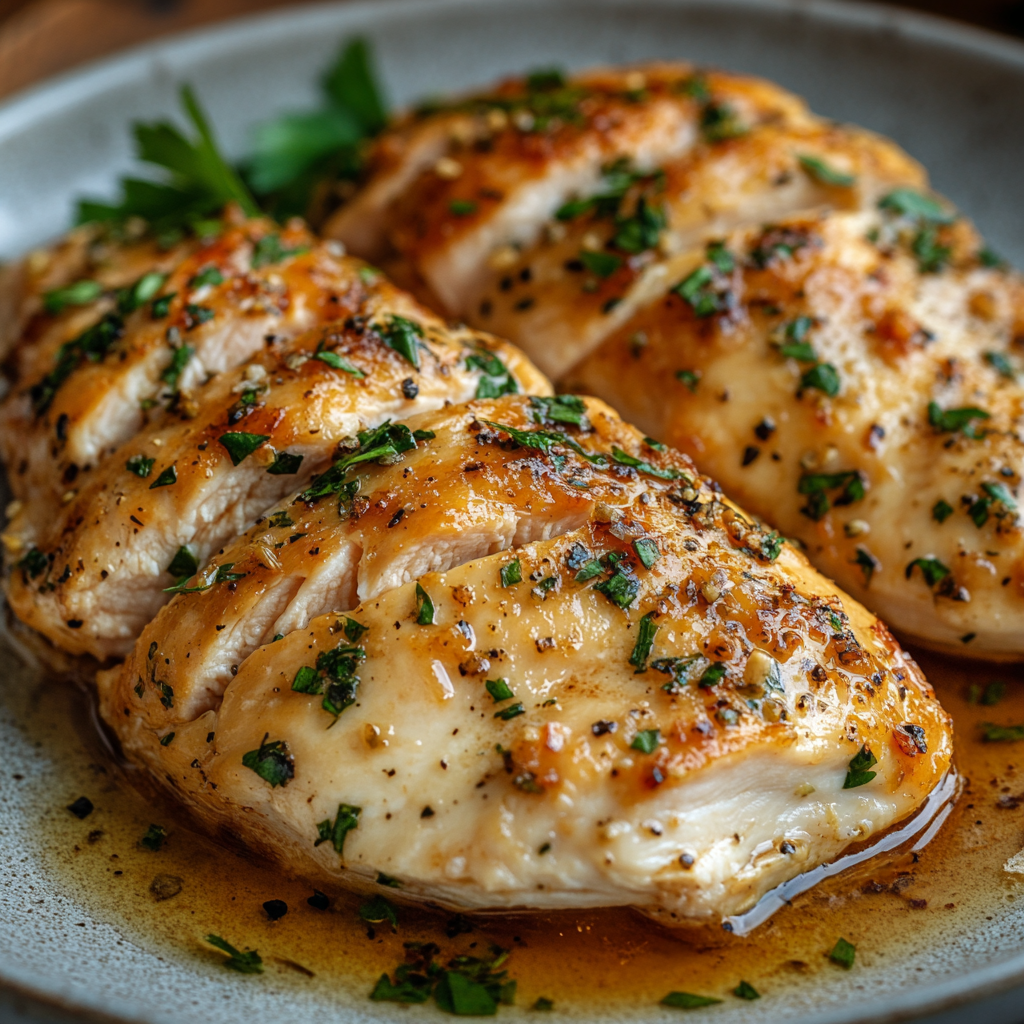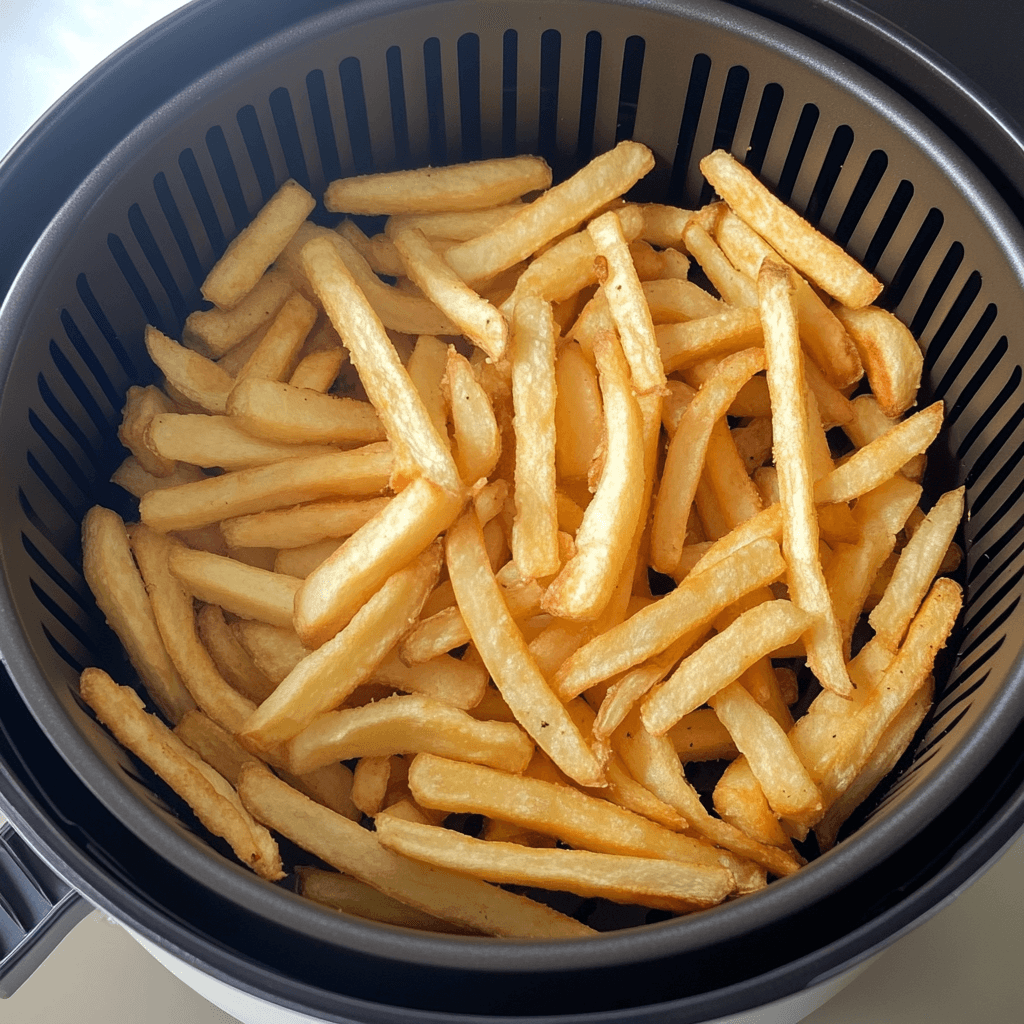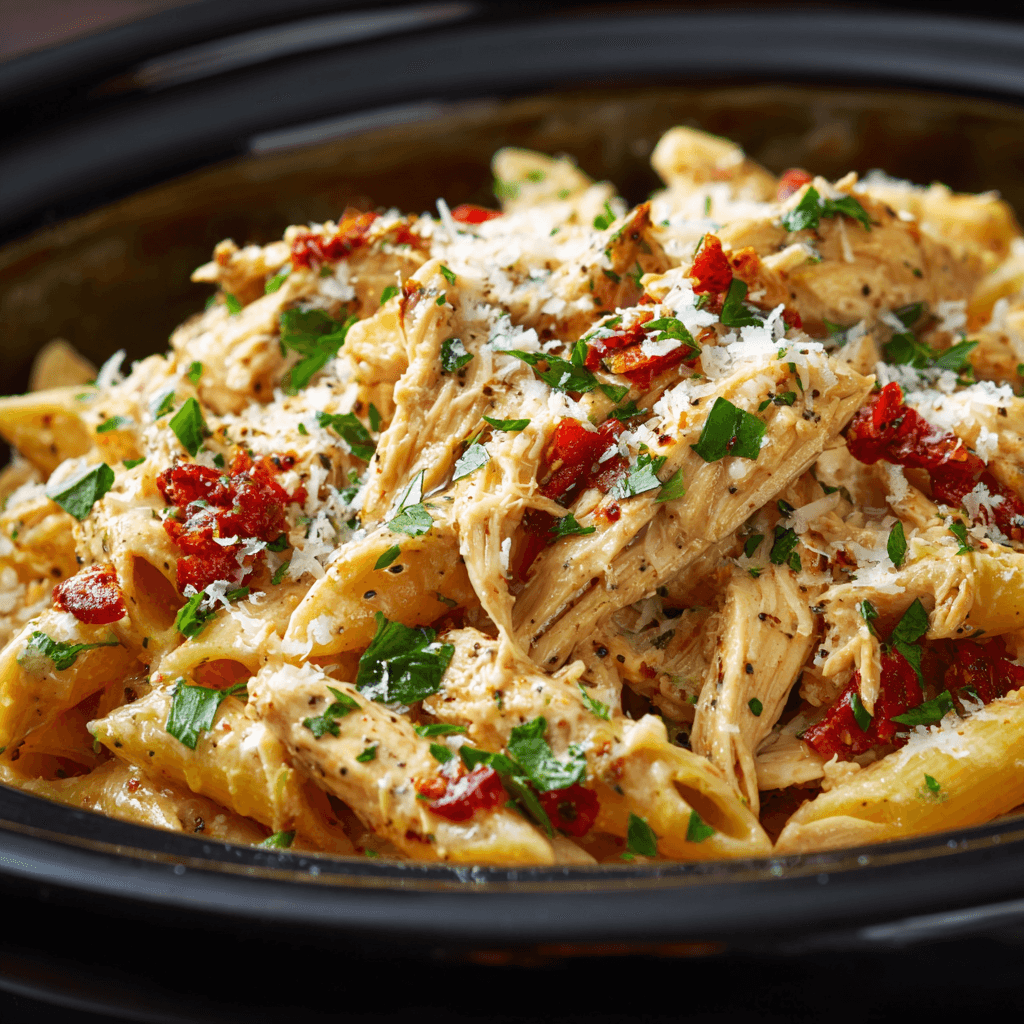Introduction to Bone-In Chicken Breasts
What Are Bone-In Chicken Breasts?
Bone-in chicken breast recipes are a go-to choice for creating flavorful and juicy meals. Whether you’re roasting, grilling, or slow cooking, these recipes deliver tender, protein-packed dishes that are perfect for any occasion. Explore the best cooking methods, seasoning tips, and pairing ideas to make the most of this versatile protein option.
Benefits of Cooking with Bone-In Chicken Breasts
- Enhanced Flavor: The bone and skin contribute to a juicier, more flavorful result compared to boneless cuts.
- Better Moisture Retention: The bone helps the chicken retain its moisture during cooking, preventing it from drying out.
- Cost-Effective: Bone-in chicken breasts are often more affordable than boneless options.
- Versatility: They work well with various cooking methods and recipes, making them suitable for everyday meals and special occasions alike.
Common Cooking Methods for Bone-In Chicken Breasts
- Roasting: Oven-roasting bone-in chicken breasts produces a crispy skin and tender meat, perfect for family dinners.
- Grilling: Adds a smoky, charred flavor while keeping the meat juicy.
- Braising: A slow-cooking method that infuses the chicken with rich, savory flavors from broths and seasonings.
- Pan-Searing: Creates a golden crust on the outside while locking in the natural juices.
- Slow-Cooking: Ideal for shredding or using in soups and stews, this method delivers fall-off-the-bone tenderness.
By understanding the benefits and versatile cooking methods, bone-in chicken breasts can become a go-to ingredient for flavorful and satisfying meals.
Choosing the Right Bone-In Chicken Breasts
How to Select Fresh and Quality Chicken Breasts
When selecting chicken breasts, there are several key factors to consider. First, pay attention to the appearance; the meat should have a light pink color with minimal discoloration. Next, check the texture, as fresh chicken should feel firm rather than soft or mushy. Moreover, the smell is another important indicator—opt for chicken with a mild, fresh scent and avoid anything with a sour or off-putting odor. Finally, examine the packaging to ensure it is intact and check the sell-by date to confirm freshness.
Understanding the Differences Between Bone-In and Boneless
It’s essential to understand the differences between bone-in and boneless chicken breasts to choose the right cut for your recipe. For example, bone-in chicken breasts retain the rib bone and often include the skin, providing enhanced flavor and juiciness due to the bone and fat content. However, they require slightly longer cooking times. On the other hand, boneless chicken breasts are easier to handle, cook quickly, and are ideal for recipes where the chicken is shredded, diced, or needs a shorter cooking time. In summary, both cuts have unique benefits, so the choice depends on the recipe’s requirements.
Best Cuts and Sizes for Specific Recipes
Choosing the right size of bone-in chicken breasts can significantly affect your dish’s outcome. For instance, large bone-in breasts are perfect for roasting, grilling, or slow cooking and are best suited for dishes like herb-roasted chicken or barbecue recipes. In contrast, medium-sized breasts are great for braising or pan-searing, especially for saucy recipes such as lemon chicken or coq au vin. Meanwhile, small bone-in breasts work well in stews, soups, or casseroles because they’re easier to shred or incorporate into mixed dishes. Thus, selecting the appropriate size ensures optimal cooking results.
By keeping these tips in mind, you can confidently choose the best bone-in chicken breasts for any recipe, enhancing both the flavor and texture of your dish.
Essential Ingredients for Bone-In Chicken Breast Recipes
Pantry Staples for Flavorful Chicken Dishes
To create flavorful bone-in chicken breast recipes, a well-stocked pantry is essential. Firstly, you’ll need basics like olive oil, salt, and pepper, which form the foundation of most dishes. Additionally, keeping garlic, onion powder, and paprika on hand ensures versatility in seasoning. For depth of flavor, consider adding soy sauce, Worcestershire sauce, or balsamic vinegar to your collection. Finally, chicken stock or broth is a must-have for moist and savory cooking.
Seasoning Options: Dry Rubs, Marinades, and Glazes
Seasoning is key to enhancing the natural flavors of bone-in chicken breasts. Dry rubs offer a quick way to add bold flavors by combining spices like cumin, paprika, garlic powder, and cayenne. Alternatively, marinades infuse moisture and flavor over time, with combinations such as lemon juice, olive oil, and fresh herbs or a soy-based mix for an Asian-inspired touch. For a finishing touch, glazes like honey mustard, barbecue sauce, or a balsamic reduction create a rich, caramelized coating during cooking.
Pairing Chicken with Vegetables and Herbs
Pairing chicken with complementary vegetables and herbs elevates the dish while adding texture and freshness. For example, root vegetables like carrots, potatoes, and parsnips roast beautifully alongside bone-in chicken breasts. Additionally, greens such as spinach, kale, or asparagus can be sautéed or roasted as lighter sides. Herbs like rosemary, thyme, parsley, and sage pair naturally with chicken, imparting aromatic flavors. Finally, citrus fruits like lemon or orange slices can be added to brighten the dish with a tangy finish.
By combining pantry staples, creative seasonings, and complementary pairings, you can create delicious and versatile bone-in chicken breast recipes that suit any occasion.
Equipment Needed for Cooking Bone-In Chicken Breasts

Tools for Roasting: Baking Sheets, Racks, and Ovens
Roasting bone-in chicken breasts is simple with the right tools. First, you’ll need a baking sheet to hold the chicken. Additionally, a wire rack placed on top allows heat to circulate for crispy skin. Finally, a reliable oven is essential. To ensure accuracy, consider using an oven thermometer to double-check the temperature.
Grilling Essentials: Grates, Thermometers, and Tongs
Grilling bone-in chicken breasts is easy with a few basics. Start with clean grill grates to prevent sticking. Then, use a meat thermometer to ensure the chicken reaches a safe internal temperature of 165°F. Lastly, long-handled tongs are helpful for flipping and moving the chicken without burning your hands.
Skillets and Pans for Stovetop Cooking
For stovetop cooking, a good skillet or pan makes all the difference. A cast-iron skillet is best for even heating and creating a crispy crust. Alternatively, a non-stick pan works well for easier cleanup. Adding a lid helps cook the chicken through by holding in heat.
These tools make it easy to cook bone-in chicken breasts using different methods, helping you achieve great results every time.
Classic Roasted Bone-In Chicken Breast Recipe
Step-by-Step Instructions for Oven-Roasting
- Preheat the Oven: Set your oven to 375°F (190°C).
- Prepare the Chicken: Pat the bone-in chicken breasts dry with a paper towel. This helps the skin crisp up during cooking.
- Season the Chicken: Rub the chicken with olive oil, then season generously with salt, pepper, and any other desired spices.
- Place on a Rack: Arrange the chicken on a wire rack set over a baking sheet. This allows heat to circulate, ensuring even cooking.
- Roast the Chicken: Bake for 35–45 minutes, or until the internal temperature of the thickest part of the breast reaches 165°F (74°C).
- Rest the Chicken: Let the chicken rest for 5–10 minutes before serving to lock in the juices.
Tips for Golden, Crispy Skin
- Dry the Skin: Always pat the chicken dry before applying oil or seasoning.
- Use High Heat at the End: For extra crispiness, increase the oven temperature to 425°F (220°C) for the last 5–10 minutes of cooking.
- Don’t Overcrowd: Leave space between the chicken breasts to ensure proper air circulation and even browning.
- Oil Is Key: A light coating of olive oil or melted butter helps the skin become crispy and golden.
Variations with Herbs and Spices
- Lemon Herb: Add fresh rosemary, thyme, and slices of lemon under the skin for a fragrant, zesty flavor.
- Garlic Paprika: Mix garlic powder, smoked paprika, and a touch of cayenne for a smoky, spicy twist.
- Mediterranean Style: Rub with a blend of oregano, basil, and a splash of balsamic vinegar.
- Honey Mustard Glaze: Brush the chicken with a mix of honey and Dijon mustard during the last 10 minutes of roasting for a sweet and tangy finish.
This classic roasted bone-in chicken breast recipe is perfect as a main dish and can be customized with your favorite herbs and spices for endless variations.
Grilled Bone-In Chicken Breast Recipe
Prepping Chicken for the Grill
- Clean and Dry the Chicken: Pat the bone-in chicken breasts dry with a paper towel to remove excess moisture, which helps achieve a better sear.
- Trim Excess Fat: Remove any large pieces of fat or skin for even cooking and to reduce flare-ups on the grill.
- Season or Marinate: Apply your favorite marinade or dry rub at least 30 minutes before grilling, or up to 24 hours for deeper flavor. If using a marinade, pat the chicken lightly to remove excess liquid before placing it on the grill.

Achieving Perfect Grill Marks and Smoky Flavor
- Preheat the Grill: Heat the grill to medium-high (about 375–400°F). Clean and oil the grates to prevent sticking.
- Start on Direct Heat: Place the chicken skin-side down on the grill over direct heat to achieve grill marks. Cook for about 4–5 minutes until the skin is golden and crisp.
- Move to Indirect Heat: Transfer the chicken to indirect heat and continue cooking with the lid closed. This allows the chicken to cook evenly without burning the outside.
- Check Temperature: Use a meat thermometer to ensure the internal temperature reaches 165°F (74°C).
- Rest Before Serving: Let the chicken rest for 5–10 minutes to redistribute the juices.
Marinades for Grilled Bone-In Chicken
- Citrus Herb Marinade: Combine lemon juice, olive oil, garlic, rosemary, and thyme for a fresh, zesty flavor.
- Barbecue Marinade: Mix your favorite barbecue sauce with a splash of apple cider vinegar for a tangy, smoky taste.
- Teriyaki Marinade: Blend soy sauce, brown sugar, ginger, and sesame oil for an Asian-inspired flavor.
- Spicy Chili Lime: Combine lime juice, chili powder, paprika, and a touch of honey for a bold, spicy kick.
This grilled bone-in chicken breast recipe delivers juicy, flavorful results with a crispy, smoky finish. Pair it with your favorite sides for a perfect summer meal!
Stovetop Bone-In Chicken Breast Recipe
Pan-Seared Chicken Breasts with Crispy Skin
- Prepare the Chicken: Pat the chicken breasts dry with a paper towel to remove moisture, ensuring the skin becomes crispy. Season generously with salt, pepper, and any desired spices.
- Preheat the Pan: Heat a large cast-iron skillet or heavy-bottomed pan over medium-high heat. Add a tablespoon of oil (olive, vegetable, or avocado oil works well).
- Sear the Chicken: Place the chicken skin-side down in the hot pan and cook for 5–7 minutes without moving it. This allows the skin to become golden and crisp.
- Flip and Cook: Turn the chicken over and reduce the heat to medium. Cook for another 7–10 minutes, or until the internal temperature reaches 165°F (74°C).
Adding a Flavorful Pan Sauce
- Deglaze the Pan: After cooking the chicken, remove it and set aside. Add a splash of broth, wine, or lemon juice to the pan to loosen the flavorful bits stuck to the bottom.
- Build the Sauce: Stir in minced garlic, shallots, or onions, and sauté for 1–2 minutes. Then, add cream, butter, or a touch of mustard for richness, along with fresh herbs like thyme or parsley for added flavor.
- Simmer and Serve: Let the sauce reduce slightly, then pour it over the chicken for a delicious finishing touch.
Searing vs. Braising for Juicy Results
- Searing: Ideal for quick cooking and crispy skin. This method locks in the juices and works well for smaller cuts.
- Braising: Combines searing and slow cooking. After searing the chicken, add liquid (such as broth or wine) to the pan, cover, and cook on low heat. This method is perfect for larger pieces of chicken, ensuring tenderness and flavor.
By choosing stovetop cooking methods like searing or braising and enhancing the dish with a rich pan sauce, you can create a restaurant-quality bone-in chicken breast meal with ease.
Bone-In Chicken Breast in the Slow Cooker
Benefits of Slow Cooking for Tender Chicken
Slow cooking bone-in chicken breasts offers several advantages:
- Maximum Tenderness: Cooking chicken at a low, consistent temperature ensures the meat stays moist and tender.
- Hands-Off Convenience: With minimal effort, you can prepare a flavorful dish while attending to other tasks.
- Flavor Infusion: The long cooking time allows spices, broths, and marinades to deeply penetrate the meat, enhancing the taste.
Flavorful Slow Cooker Recipes
- Lemon Herb Chicken: Combine chicken with garlic, fresh rosemary, thyme, lemon slices, and chicken broth. Cook on low for 6–7 hours or high for 3–4 hours.
- Barbecue Pulled Chicken: Add chicken breasts, barbecue sauce, onion slices, and a splash of apple cider vinegar. Cook on low for 6–8 hours and shred for sandwiches or tacos.
- Creamy Garlic Chicken: Mix cream of mushroom soup, minced garlic, and a touch of white wine or chicken broth. Pour over the chicken and cook on low for 6 hours.
Adding Vegetables and Broths for One-Pot Meals
The slow cooker makes it easy to create complete one-pot meals by adding vegetables and broth:
- Root Vegetables: Add carrots, potatoes, or parsnips to the bottom of the slow cooker for hearty sides.
- Greens: Include kale or spinach toward the end of cooking to avoid overcooking them.
- Broth Base: Use chicken broth, vegetable stock, or even tomato-based liquids to create flavorful sauces or soups.
Tip: Arrange vegetables on the bottom of the slow cooker to ensure they cook evenly and soak up the chicken’s juices.
Slow cooking bone-in chicken breasts is a foolproof way to achieve tender, flavorful results while effortlessly preparing a meal that’s perfect for busy days or comforting dinners.
Flavor Variations for Bone-In Chicken Breast Recipes
Lemon Herb Chicken
Lemon herb chicken is a light and zesty option that’s perfect for any occasion.
- Ingredients: Lemon juice, olive oil, minced garlic, fresh rosemary, thyme, and parsley.
- Preparation: Marinate the chicken in the lemon herb mixture for at least 30 minutes before cooking. Roast, grill, or slow cook for a fresh, citrus-infused flavor.
- Tip: Add lemon slices on top while cooking for extra brightness and presentation.
Garlic Butter Chicken
Garlic butter chicken is a rich and savory choice that’s both simple and indulgent.
- Ingredients: Butter, minced garlic, salt, pepper, and parsley.
- Preparation: Pan-sear the chicken with butter and garlic until golden and finish in the oven or on the stovetop. For a deeper flavor, baste the chicken with the garlic butter as it cooks.
- Tip: Serve with mashed potatoes or roasted vegetables for a comforting meal.
Spicy Cajun Chicken
Spicy Cajun chicken brings bold flavors and a kick of heat to the table.
- Ingredients: Cajun seasoning (paprika, cayenne, garlic powder, onion powder), olive oil, and a touch of lemon juice.
- Preparation: Rub the seasoning generously over the chicken and grill or roast until fully cooked.
- Tip: Pair with cornbread or a cooling yogurt dip to balance the heat.
Honey Mustard Glazed Chicken
Honey mustard chicken is sweet, tangy, and irresistibly delicious.
- Ingredients: Honey, Dijon mustard, garlic, olive oil, and a pinch of paprika.
- Preparation: Brush the glaze over the chicken before roasting or grilling. Baste the chicken with the glaze during cooking for a caramelized, sticky finish.
- Tip: Serve with steamed green beans or a crisp salad for a well-rounded meal.
These flavor variations allow you to explore diverse tastes and cooking styles while keeping bone-in chicken breasts exciting and versatile for any meal.
Sides That Pair Perfectly with Bone-In Chicken Breasts
Classic Sides: Mashed Potatoes, Rice, and Vegetables
Traditional sides are always a hit when serving bone-in chicken breasts:
- Mashed Potatoes: Creamy, buttery mashed potatoes provide a comforting and hearty base. Consider adding garlic or herbs for extra flavor.
- Rice: Fluffy white rice, wild rice, or seasoned pilaf complements chicken dishes with a neutral yet versatile option.
- Roasted Vegetables: Carrots, Brussels sprouts, and broccoli, roasted with olive oil and seasoning, make for an easy and nutritious side.
Fresh Salads and Light Pairings
For a lighter touch, fresh salads and simple sides can balance the richness of the chicken:
- Garden Salad: A mix of greens, cherry tomatoes, cucumbers, and a light vinaigrette provides freshness and crunch.
- Coleslaw: Creamy or vinegar-based coleslaw adds a tangy contrast to the savory chicken.
- Quinoa Salad: Combine quinoa with chopped vegetables, lemon juice, and herbs for a nutrient-packed pairing.
Bread and Pasta Options
Bread and pasta sides can round out the meal with satisfying textures and flavors:
- Crusty Bread: Warm, crusty bread or dinner rolls are perfect for soaking up sauces or pan juices.
- Herb-Infused Pasta: Toss pasta with olive oil, garlic, and fresh parsley for a simple yet flavorful accompaniment.
- Mac and Cheese: Creamy macaroni and cheese pairs wonderfully with roasted or grilled chicken for a comforting, indulgent meal.
By choosing complementary sides, you can tailor your meal to suit any occasion, whether it’s a casual weeknight dinner or a special gathering. These options ensure a well-rounded and delicious dining experience.
Nutritional Information for Bone-In Chicken Breast Recipes
Macronutrient Breakdown: Calories, Proteins, and Fats
Bone-in chicken breasts are an excellent source of nutrients and can fit into most balanced diets. For example, one medium-sized (about 6 oz) cooked bone-in chicken breast with the skin provides:
- Calories: Approximately 300–350 kcal, depending on the cooking method.
- Proteins: 30–35g, offering essential amino acids for muscle repair and growth.
- Fats: 15–20g, mainly from the skin, which includes both saturated and unsaturated fats. In comparison, removing the skin can reduce the fat content significantly.
Adjustments for Low-Calorie and High-Protein Diets
Bone-in chicken breasts can be tailored to suit various dietary preferences. For those following a low-calorie diet, removing the skin is a simple way to reduce calorie and fat intake. Furthermore, grilling, baking, or slow cooking with minimal oil helps keep the dish lighter. On the other hand, individuals focused on high-protein diets can pair chicken breasts with nutrient-dense sides like lentils or quinoa for a well-rounded meal. Additionally, using dry rubs instead of heavy sauces adds flavor without unnecessary calories.
Using Healthy Fats for Cooking
Choosing the right fats for cooking bone-in chicken breasts is essential for health and flavor. For instance, olive oil or avocado oil are excellent choices for roasting or grilling as they contain heart-healthy monounsaturated fats. Moreover, small amounts of coconut oil or sesame oil can add unique flavors to marinades. However, avoid using excessive fats by relying on non-stick pans or cooking sprays, which allow the chicken to cook evenly while staying light. Finally, incorporating these adjustments ensures a delicious and nutritious meal without compromising on taste.
By utilizing transition words and emphasizing these practical adjustments, bone-in chicken breast recipes can seamlessly adapt to different dietary needs while maintaining their appeal.
How to Store and Reheat Leftover Bone-In Chicken Breasts
Proper Storage in the Refrigerator and Freezer
To keep leftover bone-in chicken breasts fresh and safe to eat, proper storage is essential:
- Refrigerator: Store leftovers in an airtight container or wrap them tightly in plastic wrap or aluminum foil. Place them in the refrigerator within 2 hours of cooking to prevent bacterial growth. They can stay fresh for up to 3–4 days.
- Freezer: For longer storage, wrap the chicken in plastic wrap, then place it in a freezer-safe bag or container. Label it with the date for easy tracking. Frozen chicken can be kept for up to 3 months.
Reheating Methods: Oven, Microwave, and Skillet
Reheating leftover chicken while preserving its flavor and moisture requires the right technique:
- Oven: Preheat the oven to 350°F (175°C). Wrap the chicken in foil and add a splash of broth or water to keep it moist. Heat for 20–25 minutes or until warmed through.
- Microwave: Place the chicken on a microwave-safe plate, cover it with a damp paper towel, and heat in 1-minute intervals, flipping halfway through to ensure even reheating.
- Skillet: Heat a small amount of oil or butter in a skillet over medium heat. Add the chicken and cook for 4–5 minutes per side, covering the skillet to retain moisture.
Creative Ideas for Leftover Chicken
Transform leftover bone-in chicken breasts into new and exciting dishes:
- Chicken Salad: Shred the chicken and mix it with mayonnaise, celery, and seasonings for a quick and easy sandwich filling or salad topping.
- Tacos or Wraps: Remove the chicken from the bone, shred it, and use it as a filling for tacos, burritos, or wraps with your favorite toppings.
- Soup or Stew: Chop the chicken and add it to a broth-based soup or hearty stew for added protein and flavor.
- Pasta Dishes: Dice the chicken and toss it into pasta with a creamy or tomato-based sauce.
By following these storage and reheating tips and exploring creative uses for leftovers, you can reduce waste and enjoy delicious meals throughout the week.
Common Mistakes to Avoid When Cooking Bone-In Chicken Breasts
Overcooking or Undercooking
One of the most common mistakes is cooking chicken for too long or not enough, leading to dry meat or unsafe consumption.
- Solution for Overcooking: Use a meat thermometer to monitor the internal temperature. Bone-in chicken breasts should reach 165°F (74°C) at the thickest part to ensure they’re fully cooked but still juicy.
- Solution for Undercooking: Always check multiple parts of the chicken, especially near the bone, as this area can cook more slowly.
Skipping the Resting Time
Cutting into the chicken immediately after cooking is a mistake that can result in loss of juices, leaving the meat dry.
- Why Resting Matters: Allowing the chicken to rest for 5–10 minutes lets the juices redistribute, making the meat more flavorful and tender.
- How to Rest Properly: Cover the chicken loosely with foil while it rests to retain heat without making the skin soggy.
Using Inadequate Seasoning
Under-seasoning can leave bone-in chicken breasts tasting bland, while uneven seasoning may result in inconsistent flavors.
- Solution: Generously season the chicken with salt, pepper, and spices both on the skin and under it, if possible. This ensures the flavor penetrates the meat.
- Tip for Even Seasoning: Use marinades or dry rubs to coat the chicken evenly, and let it sit for at least 30 minutes before cooking to enhance flavor.
By avoiding these common mistakes, you can ensure that your bone-in chicken breasts turn out juicy, flavorful, and perfectly cooked every time.
Frequently Asked Questions (FAQs)
How Do I Ensure My Chicken Stays Juicy?
To keep your chicken juicy, avoid overcooking it and always let it rest for 5–10 minutes after cooking. Cooking methods like baking with a splash of broth or marinating the chicken before cooking can also help lock in moisture.
What Temperature Should Bone-In Chicken Be Cooked To?
Bone-in chicken breasts should be cooked to an internal temperature of 165°F (74°C). Use a meat thermometer to check the thickest part of the meat near the bone for accuracy.
Can I Use Bone-In Chicken for Meal Prep?
Yes! Bone-in chicken is excellent for meal prep because it retains moisture and flavor better than boneless cuts. Cook it in advance and store it in airtight containers in the refrigerator for up to 4 days, or freeze for longer storage.
How Long Does It Take to Cook Bone-In Chicken Breasts?
The cooking time depends on the method and temperature:
- Baking at 375°F (190°C): Approximately 35–45 minutes.
- Baking at 400°F (200°C): About 30–40 minutes for slightly quicker results.
- Grilling: Around 10–12 minutes per side.
- Slow Cooking: 6–8 hours on low or 3–4 hours on high.
Can I Substitute Boneless Chicken in These Recipes?
Yes, but boneless chicken cooks faster than bone-in, so you’ll need to adjust the cooking time. Boneless breasts typically take about 20–25 minutes at 375°F (190°C). Keep an eye on the internal temperature to prevent overcooking.
What Are the Best Ways to Reheat Bone-In Chicken?
The best methods to reheat chicken while keeping it moist include:
- Oven: Wrap the chicken in foil with a splash of broth and bake at 350°F (175°C) for 20–25 minutes.
- Skillet: Heat on low with a lid to retain moisture.
- Microwave: Use a damp paper towel to cover the chicken and heat in short intervals.
Is It Better to Bake Bone-In Chicken Breast at 350 or 400?
Both temperatures work well depending on your goal:
- 350°F (175°C): Produces a more evenly cooked, tender chicken.
- 400°F (200°C): Yields a faster cook time with slightly crispier skin.
How Do You Keep Chicken Breast Moist and Tender?
To keep chicken breasts moist, brine them before cooking or marinate them with oil and acidic ingredients like lemon juice or vinegar. Cooking at the right temperature and allowing the chicken to rest after cooking also ensures tenderness.
How Long to Bake Chicken Breast at 375 Degrees?
Bake bone-in chicken breasts at 375°F (190°C) for approximately 35–45 minutes, depending on their size. Use a meat thermometer to confirm the internal temperature reaches 165°F (74°C).
These FAQs address common questions and tips, ensuring that your bone-in chicken breasts turn out perfectly every time!
For the article on bone-in chicken breast recipes, you can enhance internal linking by connecting it to other relevant posts on the site. For example, when discussing flavorful variations for chicken dishes, consider linking to the guide on “The Ultimate Guide to Smoked Meatloaf Recipe”, which shares tips on achieving rich, smoky flavors. Additionally, when addressing side dishes that pair well with chicken, you could reference the post on “The Ultimate Guide to Making Bisquick Pancakes” for a unique breakfast pairing idea. Lastly, if you mention meal-prepping with chicken, the guide on “The Ultimate Protein Pancakes Recipe for a Healthy Start” could provide inspiration for protein-rich meal ideas. These internal links will improve navigation and keep readers engaged with complementary recipes and tips.
What’s the best way to store leftovers?
Keep leftovers in an airtight container in the fridge for up to 4 days. Reheat in the microwave or oven until hot and bubbly. For food safety tips, refer to USDA guidelines on leftovers .
Conclusion
Why Bone-In Chicken Breasts Should Be Your Go-To Protein
Bone-in chicken breasts are a versatile, flavorful, and nutrient-rich option that can elevate any meal. The presence of the bone and skin not only enhances the flavor but also helps the meat stay moist and tender during cooking. Whether you’re grilling, roasting, or slow-cooking, bone-in chicken breasts are perfect for creating dishes that are both satisfying and nutritious. Their adaptability to a wide variety of seasonings, cooking methods, and side dishes makes them a reliable choice for both casual dinners and special occasions. If you’re looking for a protein option that delivers on taste, texture, and versatility, bone-in chicken breasts are a clear winner. Try them in your next meal and experience the difference!





5 thoughts on “Best Delicious and Easy Bone-In Chicken Breast Recipes for Any Occasion”
Comments are closed.